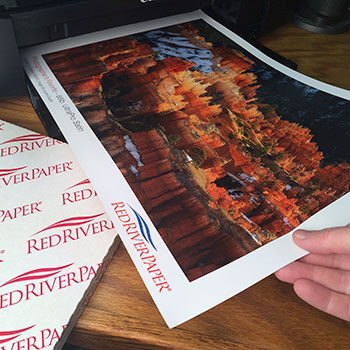The Inkjet Paper Handling Guide

Inkjet paper is not just paper. Think of it as a yet unmade piece of art. It is the potential you can unlock to make an amazing photographic or fine art work. As such, inkjet paper should be treated with care. You will get better prints and have less waste over time.
Store It Right
Store your inkjet paper in a closed box (original packaging preferred) until you are ready to use it. Protecting the paper from light, swings in humidity, dust, and atmospheric contaminants is important.
Boxes of inkjet paper should be stored horizontally, not vertically. This ensures paper will stay as flat as possible.
Handle With Care
Handle the paper by the edges or underside to avoid damaging the coated surface. Try and avoid touching the printable surface of an inkjet paper. This is especially true of photo base papers like glossy and satin. Oil, dirt, and other contaminants can alter the inkjet coating which could adversely effect print quality.
Check It Before Printing
Watch for dust and debris. Because inkjet paper is not packed in a "clean room" environment, there may be dust or paper debris on the coated surface. If left there, you may see blemishes or white blank spaces on your printed image.
It is a good idea to:
- Fan a stack of paper before putting it in your printer
- Use a fine polishing cloth to dust off the surface of paper, especially cotton fine art stock
- Use canned air to clean the interior of your printer often to remove paper dust, etc.
After the Print is Complete
Allow inkjet prints to dry completely before being handled.
All inkjet papers "out gas" during the drying process. These gasses result from water and other chemicals in inkjet ink evaporating from the inkjet coating. Avoid stacking prints for at least 30 minutes after printing. The longer you leave prints to dry before handling the better.
To speed up the out gassing process put a piece of plain copy paper on top of your print. The dry copy paper will help pull out ink moisture from your prints.
Since copy paper is acid free, it is a suitable interleaving sheet for print stacking.
One more word about print stacking. If you are using MATTE or FINE ART PAPERS with pigment inks, an interleaving sheet is highly recommend for print storage or transport. Black pigment inks rub off and scuff easily on matte and cotton papers. Keeping prints from touching is always a good idea.
Keeping Loose Prints Stored Properly
Do not expose prints to direct sunlight. Heat and UV radiation will greatly accelerate fade and paper damage
Always store prints in a climate controlled environment. 75 degrees Fahrenheit and 50% relative humidity are the benchmarks you should look to when storing prints. Moving air is a big factor in print fade. Try to keep prints in an acid free storage box or print sleeve / bag.
If you are going to store prints in plastic bags or sleeves, look for plastic material that is made from biaxially oriented polypropylene. Avoid using any materials that contain polyethylene or plasticizers which can cause rapid yellowing of your paper.
About Framing and Long Term Storage
Mark Rogers, president of Frame Destination offered some tips for framing your inkjet prints.
Just like post-printing, always allow your print to dry completely before framing. If prints continue to out gas in the frame, you might see a white residue appear on the inside of the glass. This can be easily cleaned if this happens.
Always use archival quality mounts and mat boards.
Avoid exposing your print to heat. Frame Destination recommends low-heat or pressure sensitive dry mounting substrates. Never use a high-heat substrate, and always test a sample before mounting the actual artwork.
Do not spray mount. Inkjet inks are sensitive to moisture and changes in humidity.
Do not use tape to adhere the picture to the mounting board as the adhesive in the tape can cause damage to the edges of the picture.
Use Photo Corners or Strips to Mount the Print to the Mounting Board. When it comes to mounting and framing your valuable photos, photo corners are an excellent choice. It may be tempting to take the easy way out and use spray or liquid adhesives for your photo mounting, but there is a danger to your photos. Adhesives may react with the chemicals used to produce the image in your photograph, causing substantial damage.
Use UV filtered glass in your frame. Glass is important for a number of reasons. Stopping UV light is quite important because most inkjet papers have Optical Brightener content. These OBAs "burn out" when exposed to UV light. When this happens you are left with the original color of the paper, which is often neutral white to yellowish. This is why old photos begin to look yellow over time.
Second, glass (along with the sealing the back of the frame) will protect your prints from atmospheric contaminants. Airborne chemicals and pollution are thought to play a large role in inkjet print fade.
More Resources:
Tips for feeding paper into your printer
Guide to Preservation Matting and Framing (Library of Congress)
Last updated: April 11, 2023




